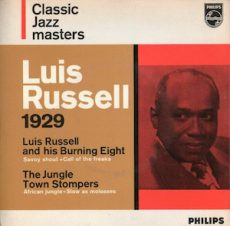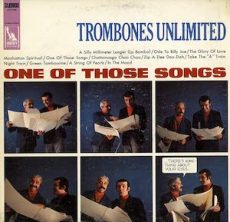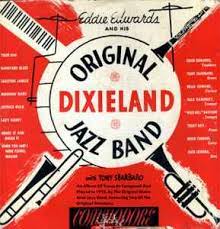
Daily Dose Of Jazz…
Harry Alexander White was born on June 1, 1898 in Bethlehem, Pennsylvania. As a teenager, he played drums, then switched to trombone after moving to Washington, D.C. around 1919. In the early Twenties he played with Duke Ellington, Elmer Snowden, and Claude Hopkins. Then in 1925 he formed the family band called the White Brothers Orchestra, which played the mid-Atlantic states for several years with regular gigs in New York City and Philadelphia, Pennsylvania.
Late in the 1920s, he played with Luis Russell, then joined the Mills Blue Rhythm Band in 1931. The following year he joined Cab Calloway’s orchestra, working as an arranger and composer in addition to his duties on trombone. One of Calloway’s trumpeters, Edwin Swayze, overheard Harry use the term “jitterbug”, and wrote a tune called The Jitterbug. Calloway’s 1934 recording of the song brought the term into widespread currency.
Returning to play with Russell in 1935 when the band was backing Louis Armstrong, he eventually quit playing for part of the Thirties decade. He would later perform with Manzie Johnson, Hot Lips Page, Edgar Hayes, and Bud Freeman.
Trombonist, pianist, saxophonist, arranger and composer Harry White, who was affectionately known as Father White, transitioned on August 14, 1962 in New York City.
More Posts: arranger,bandleader,composer,history,instrumental,jazz,music,piano,saxophone,trombone

Daily Dose Of Jazz…
Joseph Samuel Thomas was born on May 31, 1933 in Newark, New Jersey. As a child, he learned to play alto and soprano saxophone, trombone, flute and piano, and also taught himself how to write music. Encouraged by his older brother, he began performing in clubs from the age of fifteen and was ultimately noticed by James Moody.
After enlisting in the United States Army he received a Purple Heart during combat in the Korean War. Returning to the States, Joe performed with Specks Williams and joined Rhoda Scott’s Trio in the early 1960s.
Thomas recorded with organist Jimmy McGriff and released a dozen albums under his own name in the late 1970s and early 1980s. As a sideman he also recorded five albums with Scott, and one each with Ambersunshower, Beck, Buddy Terry and Joe Tex.
Flutist, tenor saxophonist and bandleader Joe Thomas passed away in Orange, New Jersey at the age of 84 on July 26, 2017.
More Posts: flute,history,instrumental,jazz,music,piano,saxophone,trombone

DELFEAYO MARSALIS & THE UPTOWN JAZZ ORCHESTRA
As an acclaimed trombonist, composer, and producer, Delfeayo Marsalis has also dedicated his prolific career to music theatre and education. Along with the Marsalis family of musicians including his father Ellis, the artist was destined to a life in music.
More Posts: adventure,album,club,festival,genius,jazz,museum,music,preserving,restaurant,travel,trombone

Daily Dose Of Jazz…
John Bernard Gordon was born May 30, 1939 in New York City, New York. He studied at Juilliard School and played with Buddy Johnson and Ray Draper in the 1950s.
Gordon worked with Lionel Hampton in 1961 and 1962 and with Lloyd Price and Sam Rivers later in the 1960s. By the 1970s, he was playing with Charles Tolliver, Clark Terry, Count Basie, Howard McGhee, and Frank Foster.
John led his own ensembles in the late 1970s, and his sidemen included Tolliver, Roland Alexander, Lisle Atkinson, Stanley Cowell, and Andrew Cyrille. During this decade he rejoined Hampton again, with whom he continued working until 1989.
After his Hampton residency Gordon played in Al Grey’s ensemble, Trombone Summit, and founded a group called Trombones Incorporated with Fred Joiner. When Joiner left the group in the early 1990s, he became its leader and changed its name to Trombones Unlimited. The late 1990s had him playing with Slide Hampton, Josh Roseman, Lafayette Harris, Martin Winder, Curtis Fuller, and Thilo Berg.
Gordon worked for several decades as a session musician for recordings and has also performed in pit orchestras for Broadway musicals. At 83, trombonist JOhn Gordon continues to play.
More Posts: bandleader,history,instrumental,jazz,music,trombone

Daily Dose Of Jazz…
Edwin Branford “Eddie” Edwards was born on May 22, 1891 in New Orleans, Louisiana and started on violin at age 10 and five years later he picked up the trombone. In 1916, he was chosen to go to Chicago, Illinois by Alcide Nunez to play trombone with Johnny Stein’s Jazz Band. With a few changes of personnel, this band became the Original Dixieland Jass Band, which made the first jazz records in 1917. He played on one of the first commercially released jazz recordings, Livery Stable Blues, later released as Barnyard Blues.
Leaving the band after being drafted into the United States Army, he served from July 1918 to March 1919. After being discharged, Eddie led his own band and worked in Jimmy Durante’s band before returning to the Original Dixieland Jass Band. After that band broke up, he again led a band in New York City for most of the 1920s until retiring from music in the early Thirties. He then ran a newspaper stand and worked as a sports coach.
Coming out of retirement he returned to music in 1936 when Nick LaRocca reformed the Original Dixieland Jazz Band, playing with them until 1938. He played in other bands with Larry Shields, Tony Sbarbaro, and J. Russell Robinson in New York City into the 1940s. He continued playing professionally intermittently until shortly before his death.
His composition Sensation Rag or Sensation was performed at the 1938 Benny Goodman jazz concert at Carnegie Hall and was included on the album The Famous 1938 Carnegie Hall Jazz Concert. Darktown Strutters’ Ball, composed by Shelton Brooks, a Black man, was recorded by the Original Dixieland Jass Band and inducted into the Grammy Hall of Fame in 2006.
Trombonist Eddie Edwards, who played both violin and trombone, and who also played minor-league baseball and worked as an electrician, transitioned on April 9, 1963 in his hometown at the age of 71.
More Posts: bandleader,history,instrumental,jazz,music,trombone,violin



